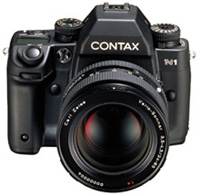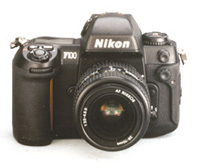Top Autofocus SLR Cameras
The Cream Of The Mid Range Crop
|
Walk into a well stocked photo dealer, or scan our mail-order ads, and you'll be overwhelmed by the sheer number of cameras available today. Even when confining the search to 35mm SLRs, you'll find over 70 listed in Shutterbug's Photography Buyer's Guide. Ranging in "street price" from under $200 to over $2000, there's at least one to suit everyone from the snapshooter to the hobbyist and the seasoned professional. Because the majority of Shutterbug readers are advanced photographers--or developing toward that level--I selected the one autofocus SLR camera from each brand that is most likely to meet most of their needs. These models are the cream of the mid-priced crop, more affordable than their "professional" counterparts, but offering most of the same advanced capabilities. Glossary For All Camera
Specifications |
|||
Contax N1 The AF system has five focus detection points arrayed in an unusual H-style pattern. They're ideally placed for image composition as per the Rule of Thirds for off-center subjects. To aid in fine focusing, the active point is illuminated in red. The central point is an x while the outer points are on a diagonal; the combination assures reliable focus with most any type of subject. Automatic focus point selection is available, but you can also select any focus point (or group of points) with the unique "joystick" control on the camera back. An AF/MF dual focus button on the camera allows for instant manual focus touchup without the need to switch from AF operation. Contax offers a unique accessory, a 1.5' square (digital) LCD monitor (FE-1) that can be attached to the camera with a cable. You can preview composition and exposure for image, in color or black and white, making adjustments until the picture seems perfect. The FE-1 has a built-in shutter release so the camera can be operated remotely. A data back is also available; it will imprint a great deal of shooting data either on the first two frames or between frames. The N1 is a large, hefty, and handsome camera that appears to be built like a tank. A die-cast aluminum alloy chassis provides exceptional strength. The body is very well sealed (with o-rings, etc.) against dust and moisture for reliability in extreme conditions. Some controls are traditional and all are large and well marked for maximum ease of use. Contax N1 Evaluation Contax N1 |
|||
Canon EOS-3 The exposure system is extremely sophisticated, with new Multi-Spot metering, 21 zone evaluative metering system, 17 zone flash meter with E-TTL flash control, and more. With an EX series Speedlite, the EOS-3 automatically switches into high-speed sync to prevent ghosting (motion blur) with moving subjects and to allow for wide apertures to be used in close-up photography on bright days. Flash Exposure Compensation and AE Lock for flash are available, too; use the 550EX, and you also get Flash Exposure Bracketing (FEB) and wireless off-camera TTL flash, too. Bearing a strong resemblance to the EOS-1 V the EOS-3 is about the same size and sports similar controls, mostly buttons plus two dials. All are extremely well marked, with a few hidden behind a small door. Anyone familiar with the EOS-1 series models will find the transition to an EOS-3 seamless. Lighter than the EOS-1 V, the EOS-3 is quite resistant to shock and moisture but has more glass-fiber reinforced polycarbonate components. Still, it feels sturdy and hefty, befitting a camera that's often used by pros as a backup to the EOS-1 models. Canon EOS-3 Evaluation Canon EOS-3 |
|||
Minolta Maxxum 7 The panel provides a great deal of data--including specifics about each of the 35 custom functions in simple text--but you can ignore anything not of immediate interest or scroll to other screens. The single most useful item for outdoor photographers is the unique depth of field bar graph, available only with the new D lenses. It provides specifics on the zone of sharpness at any aperture and focused distance, the simplest and most effective system currently available. Other notable features include a unique Smooth Trans Focus mode that produces defocused image areas without a special lens, and exposure data memory for seven rolls of film. All this may sound complicated, but the standard features of the Maxxum 7 are simple to understand and easy to access with oversized knobs and familiar input dials. Other controls are adequately large and well marked, with less frequently used controls hidden under a small door. The new autofocus system is impressive. Its unique "dual (x and +) cross-hair" central sensor and eight others canted at various angles offer reliable focus on any type of subject pattern. Any of the nine points can be selected with the rear mounted thumb pad or you can simply set the camera for automatic focus point selection. The active point lights up in red on the viewing screen. Focus can be manually touched up when desired, a first in the Maxxum system. Minolta introduced a new D-series of AF lenses offering several advantages, including a distance encoder for more accurate flash exposures with Advanced Distance Integration, when using the built-in flash or the new D-series flash units. With the latter and any AF lens, the Maxxum 7 offers flash sync to 1/8000 sec, even in wireless off-camera TTL flash photography. Other flash options include Flash Exposure Compensation and Bracketing, a first in any Minolta camera. Minolta Maxxum 7 Evaluation The innovative Navigation Display system makes this a truly unique model that will initially attract younger photographers and anyone who appreciates high-tech gear. However, even long-time photographers should appreciate this camera because of its dependable automation and versatility. These make the Maxxum 7 highly suitable for effectively capturing the most difficult subject or situation. Maxxum 7 |
|||
Nikon F100 The focus point selector thumb pad on the camera back was borrowed from the F5, and both models offer Dynamic autofocus. The F100 has five focus detection sensors--three cross-hatched and two vertical/tilted for reliable focus acquisition. High-Speed Tracking and "Lock-On" are also available: the system continues to track the original subject even if focus detection is momentarily interrupted. Tracking focus is very successful with fast action subjects moving in any direction; for lightning fast tracking, consider one of the AF-S (Silent Wave) Nikkor lenses with an ultrasonic focus motor. Few mid-priced cameras offer more light metering options and overrides. The 3D Matrix metering system is highly advanced. The microcomputer considers a complex array of factors, including brightness, contrast, selected focus area, and distance to the subject. Intelligent Multi Sensor Balanced Fill Flash is available, too, as are Flash Exposure Compensation and Bracketing plus wireless off-camera TTL flash (with an accessory) and high-speed sync with certain speedlights. Nikon F100 Evaluation Nikon F100 |
|||
Pentax MZ-S The SAFOX VII autofocus system is far more sophisticated, featuring six focus detection sensors instead of a single wide area sensor. This is certainly preferable for off-center compositions. The user can select any desired point--by pressing the AF button and turning a dial--or allow the camera to do so automatically. Apparently, its overall performance--including predictive tracking focus--is also superior. Other new amenities include high-speed flash sync and wireless off-camera TTL flash with the AF360FGZ flash unit, built-in data back for printing exposure data between frames, and an illuminated lens mount index for convenience in low light. There's also a feature not mentioned in Pentax literature: reflex mirror lockup with the 2 sec self-timer. The top film advance rate is 2.5 fps. This is a handsome camera with a unique, rounded style. Moderately small and lightweight, its major components are made of light but rigid magnesium alloy. The "direct-access" control dials and LCD data panel are slanted backward so they're easy to see with a slight shift of the eye from the viewfinder. Their operation should require only a quick review of the Owners Manual, and overall, the MZ-S appears to be less complicated than the PZ-1p. Pentax MZ-S Evaluation Pentax MZ-S |
|||
Sigma SA-9 Although it uses the same single, cross-type autofocus sensor as the SA-5, the algorithms have been upgraded. In the low light of the PMA trade show, response was quick. According to a Sigma rep, its tracking focus system has also been improved. The SA-9 is also loaded with virtually every capability and override, as noted in the specs. Some of the most significant include reflex mirror lockup, eight segment evaluative metering, built-in data back, and high-speed flash sync plus wireless off-camera TTL flash with the new EF-500 Super flash. Its fully electronic SA mount accepts any of the vast range of Sigma lenses, from 8-800mm, adequate to satisfy most every need. Many of the newer lenses include a Hypersonic Focus Motor (ultrasonic) for silent and fast operation. Sigma SA-9 Evaluation Sigma SA-9 Mid-Range AF-SLRs Manufacturers/Distributors |






































